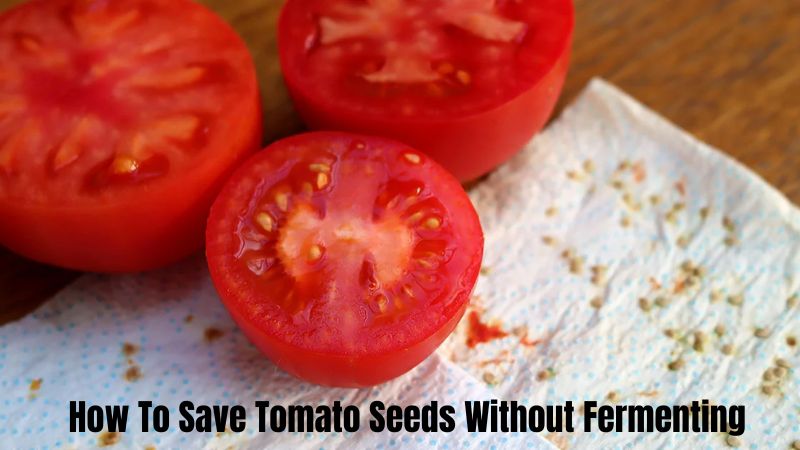How to save tomato seeds without fermenting is an important technique to ensure you have high-quality seeds for the next growing season. When how to save tomato seeds without fermenting can maintain freshness and good germination, helping you save money on buying new seeds and maintain your favorite tomato varieties. In this article, Garden Creatives will explore specific how to save tomato seeds without fermenting, helping the seeds retain their purity and be ready for the new season.
Is It Possible To Get An Exact Copy Of The Tomato I’m Saving Seeds For?
The answer depends entirely on the type of seeds you’re saving: heirloom tomatoes, hybrid tomatoes, or tomatoes you buy from the grocery store.
Heirloom Tomatoes
Heirloom tomato seeds produce tomatoes just like the parent plant. (Sometimes you’ll see heirloom tomatoes referred to as open-pollinated varieties.) This means that if you grow Brandywine tomatoes, harvest seeds from the resulting fruit, and then plant those seeds, you will Get Brandywine tomato plants.
Rarely, if two different tomato plants are grown very close to each other, they can cross-breed. This cross-pollination causes the resulting tomato seeds to become hybrids, which will behave like hybrid tomatoes (read about them just below this section). However, this is quite rare so it’s not really a concern.
Most of the time, when you save seeds from heirloom tomato plants, you will get a plant of the same variety.
Hybrid Tomatoes
Hybrid tomatoes are the result of crossing two different tomato varieties. These tomatoes will never produce an exact replica of the tomato you planted the seed from, due to genetic differences. If you’re okay with getting a completely random tomato (mystery can be fun!) then you could try growing seeds from a hybrid, just to see what you get.
However, you won’t get an exact copy of the tomato variety you’re saving seeds for if it’s a hybrid.
Tomatoes From The Grocery Store
Tomatoes in the grocery store are often hybrids. Many hybrid varieties are bred to have better long-distance transportability than fragile heirloom varieties. Occasionally you may come across an heirloom variety in the produce section, but they are usually clearly labeled if at all.
If the label doesn’t say that the tomato is an heirloom variety, there’s a good chance it’s a hybrid. In this case, you will not get an exact copy of the tomato variety you are saving seeds for, due to the genetic differences of the hybrids.
How to save tomato seeds without fermenting
Preserving unfermented tomato seeds is an important step to ensure the seeds retain their best quality for the next growing season. Below are detailed and effective steps to preserve unfermented tomato seeds.
1. Select Tomatoes to Get Seeds
When choosing tomatoes for seeds, it’s best to choose overripe ones, if possible. This means the tomato is still intact, not moldy or rotten, but has passed the perfect ripeness to eat, may be a bit soft and no longer appealing to eat fresh.
Seeds from overripe tomatoes are usually more ripe and have a higher germination rate. However, this does not mean that you cannot get seeds from ripe, bite-sized tomatoes. In fact, you can still save seeds from medium-ripe tomatoes and get good results. But if you happen to have an overripe tomato that’s not to your taste, it’s a great candidate for seeding.
However, avoid using unripe tomatoes! Underripe tomatoes will not yield good results because the seeds have not had a chance to fully develop, and this will result in a low germination rate. When in doubt, choose tomatoes that are ripe or nearly damaged instead of green ones.
Spoiled tomatoes can also be used to save seeds, but for some people, that may not be appealing. Especially if you want to avoid unwanted fermentation! When tomatoes begin to rot, they are partially fermented, which can lead to an unpleasant odor and attract fruit flies if the seeds are left to dry in environments with high temperatures and humidity.
2. Collect Seeds From Tomatoes
Cutting the Fruit: Use a clean knife to cut the tomato in half horizontally.
Remove Seeds: Use a spoon or your fingers to skillfully remove all the seeds and surrounding gel from the fruit. Place the seeds and gel in a small cup or bowl.
3. Wash Tomato Seeds
Separating Seeds from Gel: To prevent tomato seeds from fermenting, place seeds in a sieve and rinse under gently running water. Use your hands or a spoon to gently stir to remove the gel layer surrounding the seeds. Be careful not to damage the seeds.
Soaking the Seeds: Another method is to soak the seeds in clean water for about 24 hours to let the gel layer separate. Then, wash the seeds as above.
4. Dry Seeds
Prepare the Drying Surface: Spread the seeds on a flat surface such as a plate, tray, or absorbent paper. Make sure this surface is clean and dry.
Drying Seeds: Place seeds in a cool, dry place, away from direct sunlight. Dry the seeds for about 5-7 days until the seeds are completely dry. The dried seeds will feel hard to the touch and will no longer be sticky.
5. Preserving Seeds
Choose Storage Equipment: Use paper bags, envelopes, or sealed plastic containers to store seeds. Make sure storage equipment is clean and dry.
Labeling: Don’t forget to label the harvest date and tomato variety on the storage container. This will make it easier for you to track and use the seeds for future growing seasons.
Store in a Dry Place: Place seeds in a dry, cool, and dark place for best preservation. The ideal temperature for storing tomato seeds is between 5-10°C.
6. Periodic Inspection
Check the seeds occasionally to make sure they are not moldy or attacked by pests. If you find damaged seeds, remove them immediately to avoid spreading them.
7. Additional Tips for Preserving Unfermented Tomato Seeds
Using Silica Gel: To keep seeds dry, you can add silica gel packets to the box or storage bag. Silica gel helps absorb moisture and protects seeds from mold.
Freezing Seeds: Another method for long-term storage of seeds is freezing. Make sure the seeds are completely dry before placing them in a sealed plastic bag and placing them in the freezer. When needed to use, let the seeds come to room temperature before planting.
Conclude
how to save tomato seeds without fermenting is a simple process but requires meticulousness and patience. By carefully selecting, washing, drying and storing properly, you will have high-quality tomato seeds for the next growing season. This not only helps maintain your favorite tomato varieties, but also ensures a more successful next season. Apply the above steps to preserve tomato seeds effectively and economically, helping you get delicious, succulent and nutritious tomatoes for your favorite dishes.





